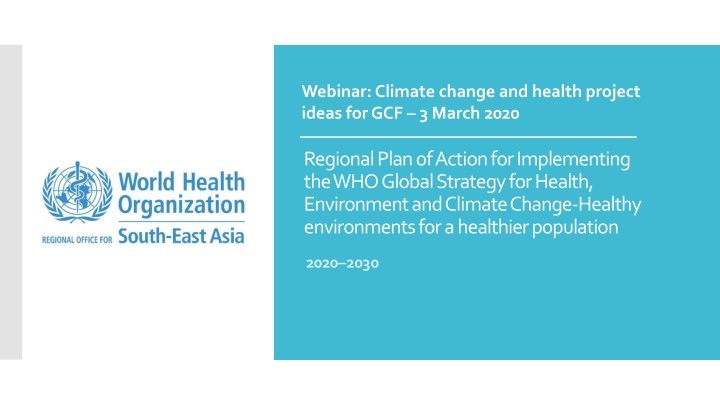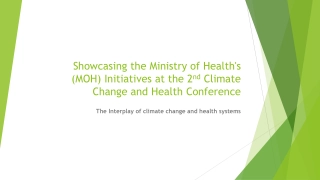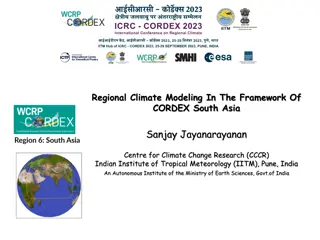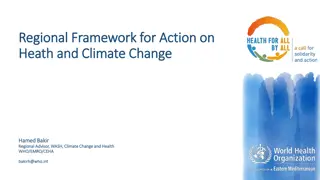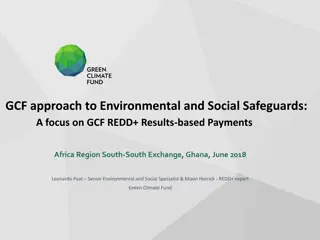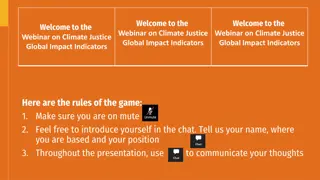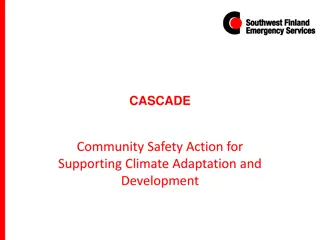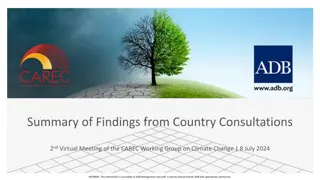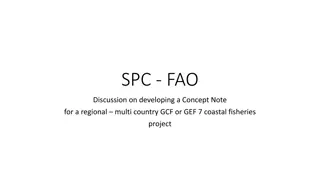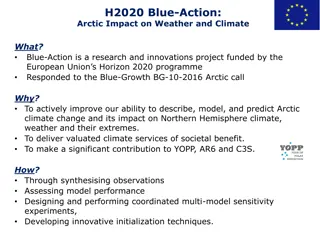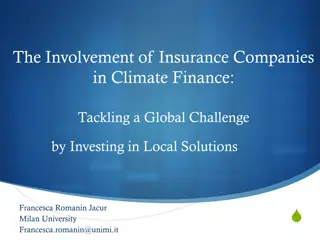Webinar on Climate Change and Health Project Ideas for GCF Regional Plan
The WHO South-East Asia Regional Plan of Action outlines key components for addressing health, environment, and climate change. It emphasizes leadership, health workforce, adaptation assessment, risk monitoring, research, sustainable infrastructure, and more. The plan focuses on national and regional actions to strengthen climate change and health initiatives.
Download Presentation

Please find below an Image/Link to download the presentation.
The content on the website is provided AS IS for your information and personal use only. It may not be sold, licensed, or shared on other websites without obtaining consent from the author.If you encounter any issues during the download, it is possible that the publisher has removed the file from their server.
You are allowed to download the files provided on this website for personal or commercial use, subject to the condition that they are used lawfully. All files are the property of their respective owners.
The content on the website is provided AS IS for your information and personal use only. It may not be sold, licensed, or shared on other websites without obtaining consent from the author.
E N D
Presentation Transcript
Webinar: Climate change and health project ideas for GCF 3 March 2020 Regional Plan of Action for Implementing the WHO Global Strategy for Health, Environment and Climate Change-Healthy environments for a healthier population 2020 2030
The WHO South-East Asia Regional Plan of Action for implementing the Global Strategy for Health, Environment and Climate Change is a 10-year set of actions for realizing the Global Strategy at the regional level. The Plan of Action builds upon the following: othe Mal Declaration on Building Health Systems Resilience to Climate Change endorsed at the Seventieth session of the WHO Regional Committee for South-East Asia (Maldives, 2017). othe Framework for Action in Building Health Systems Resilience to Climate Change in WHO South-East Asia Region 2017 2022 (operational guidance for implementing the Mal Declaration) odiscussions at the Thirty-second Meeting of Ministers of Health of the WHO SEA Region in Dhaka, Bangladesh, 2014 othe eight Regional Flagship Priority areas for achieving health imperatives in the Region oresolutions adopted at the World Health Assembly About the Regional Plan of Action
Component 1 Leadership and governance Component 2 Health workforce Component 3 Vulnerability, capacity and adaptation assessment Key Components of the Regional Plan of Action Component 4 Integrated risk monitoring and early warning Component 5 Health and climate research Component 6 Climate-resilient and sustainable technologies and infrastructure Component 7 Managing the environmental determinants of health Component 8 Climate-informed health programmes Component 9 Emergency preparedness and management Component 10 Climate and health financing
Guiding action National actions Regional Actions Deliverables Strengthen CC&H unit with focal point and budget Develop coordinating platforms for CC&H focal point to other climate-sensitive programmes and health- determining sectors (such as water, environment, agriculture, energy). Competent and functional climate change and health (CC&H) unit in each country Regional Indicators- Provide training to CC&H focal points. 1 Leadership and governance Provide guidance in development/revision of the HNAP. Develop/revise health national adaptation plan (HNAP). Advocate on climate and health for policy-makers. Provide in-service training for selective health workforce on CC&H. Integrate climate and health modules in existing curricula/courses such as community medicine and public health. Develop and implement a CC&H communication strategy (awareness and advocacy). Updated HNAP Readiness Activity Continue advocacy on CC&H at global, regional and national levels. Update regional training modules. Health professionals with better awareness and understanding on CC&H (both at executive and operational levels) 2 Health workforce
Guiding action National actions Regional Actions Deliverables Develop regional pool of expertise (individual/institution) on climate and health. Designate at least one regional institute as WHO collaborating centre on climate and health. 3 Vulnerability, capacity and adaptation assessment Health V&A developed and reported for each country Develop/update health vulnerability assessment. Prioritize at least three CSDs and develop integrated monitoring system with climate data. Prepare health risk maps for the selected three CSDs. Pilot-test early warning system for these CSDs. Develop and implement effective risk communication strategy for the health issues of concer.n Early warning system developed, for at least three country- selected CSDs Regional Indicators (1/2) 4 Integrated risk monitoring and early warning Identify experts to support countries in analysis of health and climate data in order to develop/strengthen early warning system. Set up national research agenda on CC&H through participatory process. Facilitate access to meteorological data and develop capacity for conducting research on health impacts and effectiveness of adaptation measures. Establish/strengthen and support research networks, within and across country. Integrate research dissemination in the broader communication strategy, including promoting research policy linkage. Formulate and implement plans of action to promote climate- resilient health facilities, including 1. assess vulnerability of health-care facilities to climate risks and implement interventions to make them resilient to climate change (retrofitting to make them safe from various climatic hazards such as flooding, storms); 2. ensure that new health-care facilities incorporate climate risks in their building design and siting is in safe areas; 3. implement sustainable and environment-friendly products and services in health-care facilities (water, waste management, locally grown food, renewal energy). Promote measurement of the health sector carbon footprint and implement measures to reduce emissions and monitor progress, inter alia, as the role model to other sectors. Facilitate south south cooperation on climate and health research or exchange of experience. Develop and support SEA Region CC&H research network. Climate and health research initiated in countries 5 Health and climate research Readiness NAP Activity Develop a guidance tool for assessing the vulnerability of health-care facilities to climate change. Document and disseminate the good practices in the Region. Vulnerability of health-care facilities identified by countries 6 Essential medical products and technologies
Guiding action National actions Regional Actions Deliverables Develop and promote the use of tools for integrated monitoring of air quality and health data. Strengthen existing monitoring system for air quality and link with disease surveillance for promoting cross-sectoral action. Strengthen water quality monitoring system and capacity. Implement climate-resilient water safety plans in both health-care facilities and communities. Integrated air quality monitoring developed 7 Management of environmental determinants of health Regional Indicators (2/2) Develop guidance for climate- resilient water safety plans. Develop tools to advocate for climate change risks to various CSD programmes. Support Member States to develop/update risk maps for selected areas. Water safety plan strengthened Develop risk map for CSDs using geographical information systems (GIS). Develop preventive measures for those most at risk based on risk maps. Ensure climate change risks are considered in the planning and implementation process of CSD control programmes. Climate risks included in planning and implementation of CSD programmes 8 Climate-informed programmes Include climate-sensitive health risks in national disaster risk reduction strategy or plans. Include climate risks in emergency preparedness and response plans for health facilities. Prepare contingency plan for extreme weather event management. Liaise with WHO emergency team to include climate risks in their risk reduction plans and programmes. Facilitate development of regional/subregional/country- specific proposals and submission to potential funding agencies. Develop tool for tracking finance in climate and health work. Readiness NAP Activity 9 Emergency preparedness and management Climate risks included in disaster risk management plans Conduct needs assessment and resource monitoring exercises for CC&H. Develop resource mobilization plan/strategy (domestic and external) with proactive role of the health sector. Conduct sensitization and advocacy exercises within and outside the health sector for allocation of resources to address climate risks. Develop quality CC&H proposals for development partners, preferably on co-financing basis. Funds mobilized for adaptation and mitigation measures 10 Climate and health financing
Democratic Socialist Republic of Sri Lanka Deliverables Kingdom of Bhutan Republic of Indonesia Republic of the Union of Myanmar Federal Democratic Republic of Nepal Kingdom of Thailand Democratic Republic of Timor-Leste Competent and functional climate change and health (CC&H) unit in each country Yes Yes No Yes Yes Yes Updated HNAP Health professionals with better awareness and understanding on CC&H (both at executive and operational levels) Health V&A developed and reported for each country Early warning system developed, for at least three country-selected CSDs Yes Yes No Yes Yes Yes How do some of our countries fare? No Yes Yes No Yes Yes Yes Yes Yes No Yes Yes Yes Yes Yes Yes In process Yes No Climate and health research initiated in countries No No No No Yes Yes No Vulnerability of health-care facilities identified by countries Integrated air quality monitoring developed Yes No Yes No In process Yes No No No No Yes No Yes Water safety plan strengthened Climate risks included in planning and implementation of CSD programmes No No Yes Yes Yes No Yes No In process Yes No Climate risks included in disaster risk management plans No No Yes No No Yes No Funds mobilized for adaptation and mitigation measures Yes No No No Yes Yes No
